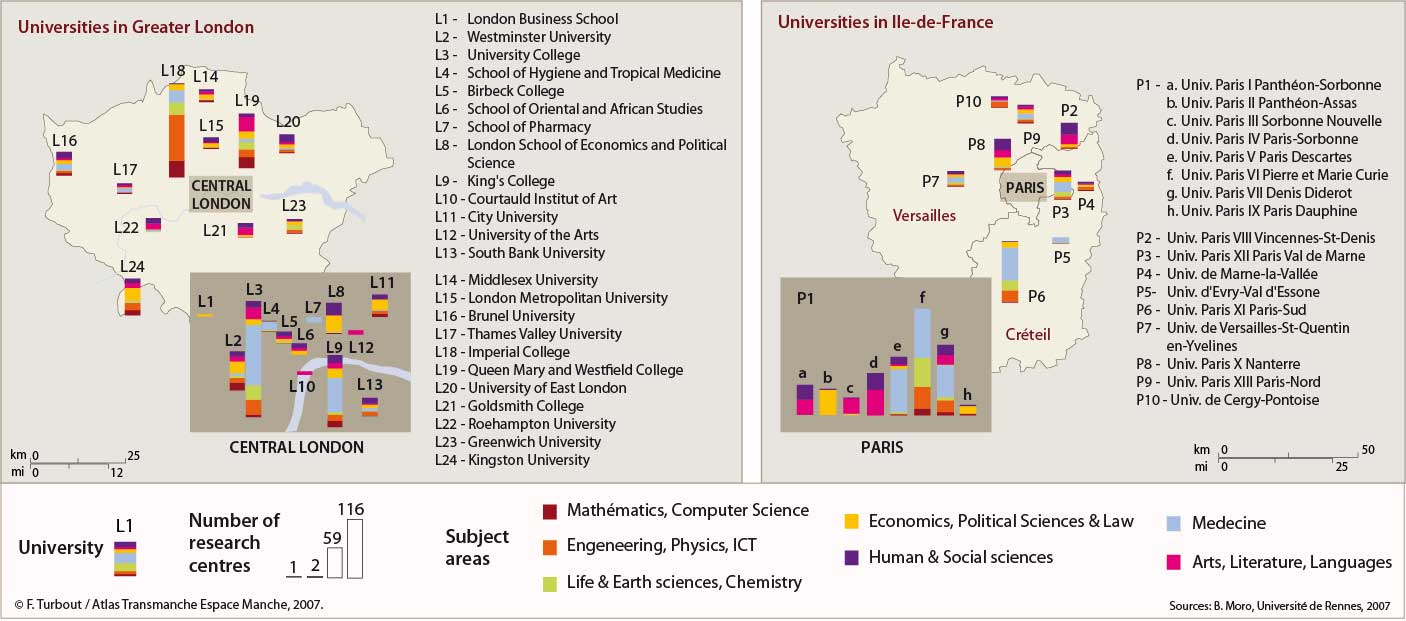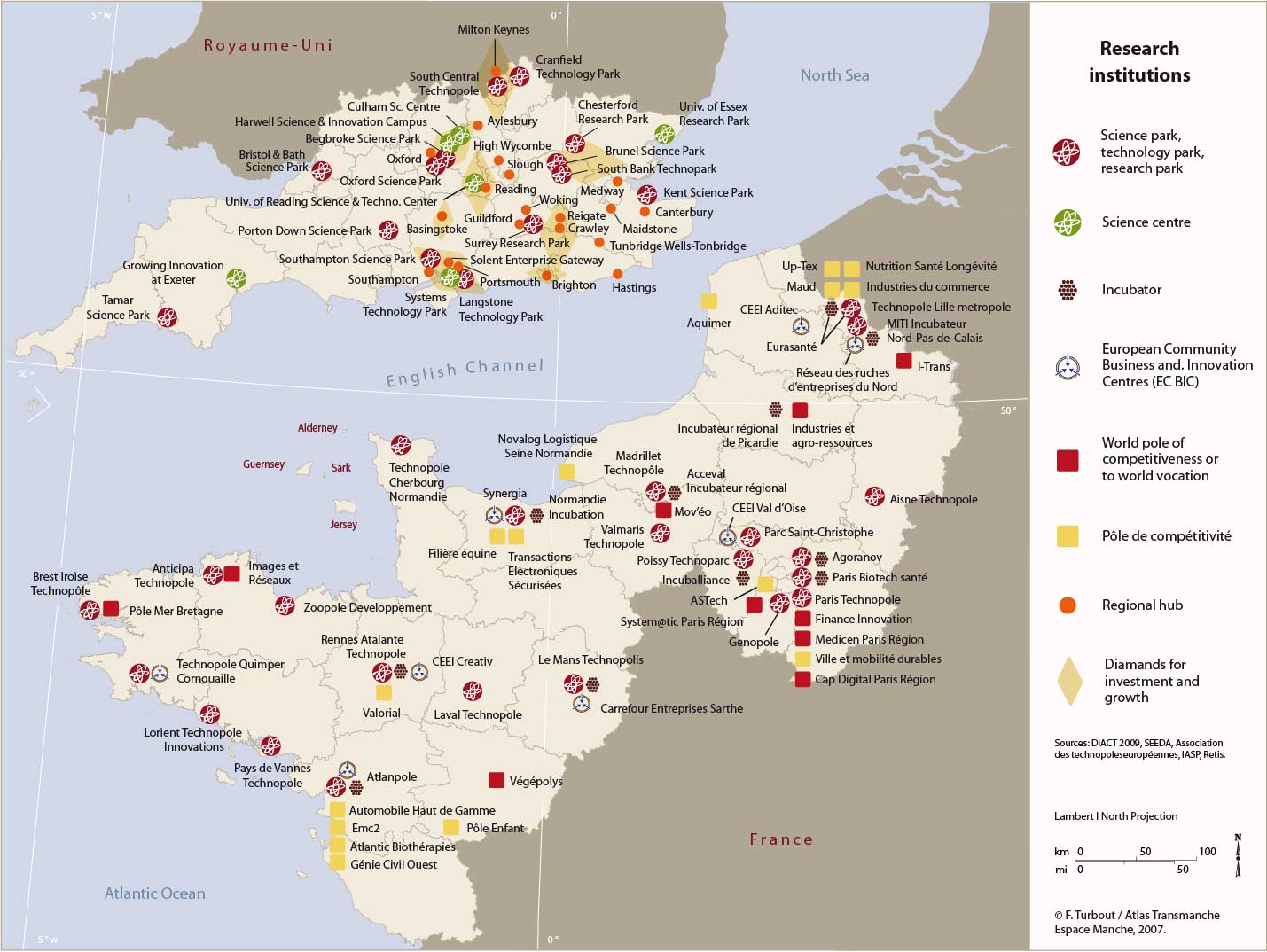

 Education - Research
Education - Research- Education in England
- R&D (2002) : Basse-Normandie FR
Commonly referred to by its anglicised acronym, R&D has become almost synonymous with the new industrial spaces that have grown up in the wake of the transition to a post-Fordist economy. The high technology ‘sunbelt' corridors, technopoles, science parks and innovation centres, themselves confirm a trend towards reagglomeration of production, which has gone hand in hand with increased global reach. The latter became clearly evident in the aftermath of the economic crises of the 1980s, with R&D taking on a cutting edge role. The introduction of innovation in product development increased both value and productivity. It became clear that when one fostered a new culture of integration of research and development, in an often complex, multi-scale interdependent environment, new synergies would follow.
Given the world-wide competitive market, there is a constant need to maintain and develop a lead advantage through R&D. London, with its ‘Western Crescent'/M4 cluster, and Paris' ‘Ile de France Sud,' have sought to emulate South California's Silicon Valley and have already achieved considerable critical mass. Grasping the essence of R&D is easier than defining it. Research, of course, is at the centre, whether conducted in government owned or private organisations (or a mix of the two). Equally, at different times, emphasis may vary, from point of invention to the general release of a new product. The nature of the activity itself covers the full spectrum from fundamental to applied research, from molecular science and materials analysis through to problem solving and systems development across all sectors.
The strategic importance of R&D has necessarily brought university and research institutions closer to industry; many teaching departments in Britain with research specialisms in applied fields, such as medical science, are now largely underpinned by external funding. This market led orientation has increased significantly in recent decades with universities developing their own R&D or ‘enterprise' companies, leading in turn to the creation of small science parks (as at the Chilworth Centre, Southampton University). Different histories, legal frameworks and practices between French and British universities have not prevented agreement on the need to create the right environments. Most crucial was the need for public-private sector partnerships, which in France saw the creation of new style semi-public or ‘mixed economy' organisations at both local (i.e. city) and regional levels.
This aspiration to provide a meeting point between research and development was most clearly seen in the growth of technopoles. Synergy was the operative word; the physical clustering together in a fully serviced environment, often a carefully landscaped parkland, of research laboratories, high tech ‘lead' enterprises, relevant producer services ... with good communications connectivity and within easy reach of local university campuses. All was designed to stimulate collaboration and innovation in a favourable and supportive environment.
The map of R&D across the Channel region reveals a growing network of such developments, many now well established. Size, type and style of operation vary considerably. All have sought to achieve partnered activity and critical mass, particularly in university towns. Immediately evident is the lower correlation on the English side with the urban hierarchy, with R&D focussing on sites away from the larger agglomerations and almost always on the fringes of cities. This is clearly the case with the growth and spread of ‘Motor Sport Valley' across semi-rural Oxfordshire. On the French side, outside Paris, it was the main regional capitals and industrialised urban areas that attracted the earliest R&D. Brittany provided a notable exception with the growth of a telecom-electronics pole around Lannion, as part of industrial decentralisation policy in the 1960s. The most important technopoles today are at Rennes, Caen, Rouen and Lille.
The last decade has seen the public sector regional development agencies on both sides of the Channel assume a much higher profile in the vigorous promotion of R&D. SEEDA, in southeast England launched its ‘Diamonds for Investment and Growth' while French counterparts identified ‘competition poles,' designed to concentrate investment to maximum effect. Another common thread is provided by size of company involved, with small to medium dominating in this new-found synergy. What is not yet greatly in evidence are projects with a cross-Channel dimension, despite flows of investment in both directions. Such long awaited collaboration could come about in the next decade through the EU sponsored ‘European Centres for Enterprise and Innovation.'
top















